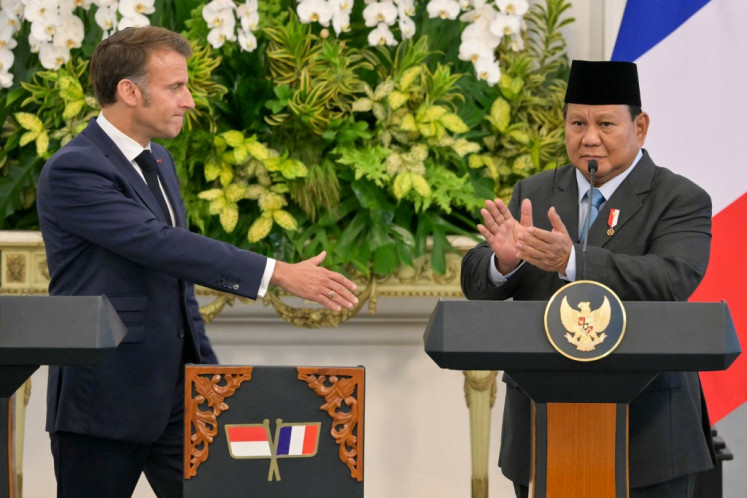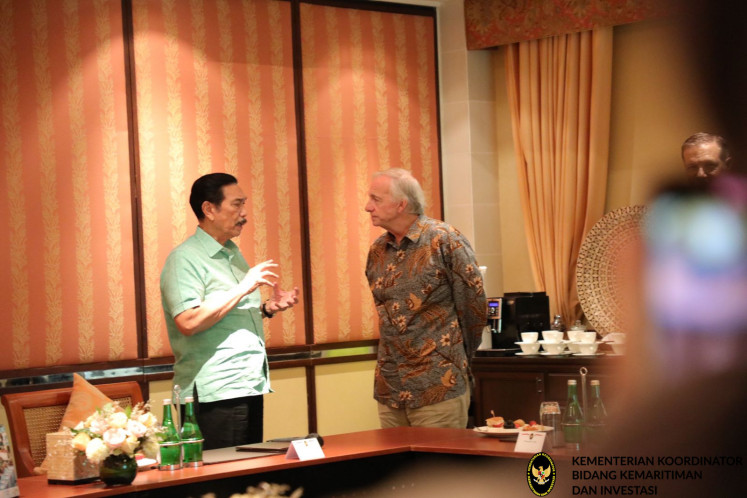'The Warrior Daughter' The Journey of the Silver Queen
In conversations about Balinese silver jewelry, the name of Desak Nyoman Suarti is sure to come up
Change text size
Gift Premium Articles
to Anyone

In conversations about Balinese silver jewelry, the name of Desak Nyoman Suarti is sure to come up.
Desak Nyoman Suarti 'popularly known as the silver queen ' has gained recognition for her efforts to promote and preserve the country's culture through her designs.
Her success stories have been documented by actress-writer Happy Salma in her latest book, The Warrior Daughter: A Creative Biography of Desak Nyoman Suarti.
'The first time I met her, I felt straight away that more people should know about her; not just her designs, but also her struggles in finding her true self and fighting for it,' Happy said during the book's recent launch.
Happy got to know Suarti through her jewelry business partner, Dewa Sri Luce, who is also Suarti's daughter.
She was surprised to learn that many of Suarti's designs were kept locked away in boxes, often forgotten about.
'I kept asking Suarti to publish a book about her hidden collection. When she finally agreed, she asked me to write it,' she said.
Luce freed the designs from their prisons, sorting through them all to find the ones she would publish in her book.
'It took me four years to complete the book.'
The book consists of six chapters and is written in both Indonesian and English. Its cover displays one of Suarti's signature pieces ' the Sarashvati diadem known as the Jamang Saraswati that she made in 1990.

Inside, readers will find images of Suarti's silver designs ' ranging from rings, bracelets and necklaces to watches and ceremonial instruments and cutlery.
Several photos of Suarti's sketches of jewelry also appear.
Warrior Daughter also takes on Suarti's personal stories ' her marriages, heartbreaks and homesickness ' along with her struggles to build her silver kingdom.
The book's first chapter digs deep into Suarti's stance on the patent rights of Balinese artwork.
She established an institution under the banner of the Forum Peduli Budaya Bali (Balinese Culture Awareness Forum), gathering seven art-related associations to protect Balinese artists and their works.
The book revealed that the forum emerged after a Balinese artist, Deni Aryasa, was sued by Canadian businessman John Hardy for copying the motifs patented by his jewelry company.
Suarti herself had gone through similar case in 1986 when she had to face an American silversmith who had staked a claim on various motifs from Indonesia at a New York court.
In the second chapter, Happy writes about young Suarti, who grew up immersed in art; her father was a painter and her mother a traditional drama player.
Suarti, now 57, learned about Balinese dance from her grandmother, Jero Nesa, before going on to study dance with dancing maestro Anak Agung Mandra, later winning many dance competitions in Bali.
In the 1970s, she went to Japan and Singapore, where she taught Balinese dance at a number of schools and universities.

The book also tells of Suarti's passion for painting ' a skill that she learned from Rudolf Bonnet, a renowned Dutch artist who resided in Ubud during the 1920s and 1940s.
Suarti disregarded the cultural norms that disapproved of women painting, becoming the first Balinese woman to hold an international painting exhibition in Singapore.
It is not, in fact, until chapter 4 that Suarti's journey in jewelry design begins, beginning with her meeting her first husband, Charles Levine, before moving to New York-- a city that launched her career.
She studied design at New York University and was later discovered by Henri Bendel, owner of a prestigious jewelry shop in the city. Bendel put on a show of Suarti's works, attracting great attention and acclaim.
She subsequently received offers to design jewelry collections at several top fashion brands, participating in trade shows and appearing on home shopping networks.
The next chapter shares the period of her homecoming to Indonesia in 1990 until today. She set up the Suarti Design Center to develop the concept and ideas for the products and also in 2001established the Luh Luwih Foundation, an institution encouraging and aiding Balinese women to explore the arts.
'In Bali, those who come from the warrior cast have a duty to preserve the arts. The knowledge has been passed down from generations and now I want to protect my heritage through the institutions and skills that I have built,' Suarti says.
Her jewelry designs are not limited to Balinese motifs; she also developed cultural designs from several ethnic groups in the archipelago, including the Dayak of Kalimantan.
'This book is also a way to preserve the nation's arts and culture. It's just the beginning, and there will be more to come.'









